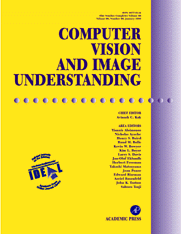 P.-M. Jodoin, M. Mignotte.
P.-M. Jodoin, M. Mignotte.
Optical-flow based on an edge-avoidance procedure
Computer Vision and Image Understanding,
Abstract:
his paper presents a differential optical flow method which accounts for two
typical motion-estimation problems : (1) flow regularization within regions
of uniform motion while (2) preserving sharp edges near motion discontinuities
i.e., where motion is multimodal by nature. The method proposed is a modified
version of the well known Lucas Kanade (LK) algorithm. While many edge-preserving
strategies try to minimize the effect of outliers by using a line process or a
robust function, our method takes a novel approach to solve the problem. Based
on documented assumptions, our method computes motion with a classical least-squares
fit on a local neighborhood shifted away from where motion is likely to be
multimodal. In this way, the inherent bias due to multiple motion around moving
edges is avoided instead of being compensated. This edge-avoidance procedure is
based on the non-parametric mean-shift algorithm which shifts the LK integration
window away from local sharp edges. Our method also locally regularizes motion
by performing a fusion of local motion estimates. The regularization is made with
a covariance filter which minimizes the effect of uncertainties due in part to noise
and/or lack of texture. Our method is compared with other edge-preserving methods
on image sequences representing different challenges.
Keywords:
Optical flow, motion estimation, information fusion, mean-shift
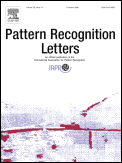 M. Mignotte.
M. Mignotte.
A non-local regularization strategy for image deconvolution.
Pattern Recognition Letters,
2008.
Abstract:
In this paper, we propose an inhomogeneous restoration
(deconvolution) model under the Bayesian framework exploiting a non
parametric adaptive prior distribution derived from the appealing
and natural image model recently proposed by Buades et al. for
pure denoising applications. This prior expresses that acceptable
restored solutions are likely the images exhibiting a high degree of
redundancy. In other words, this prior will favor
solutions (i.e., restored images) with similar pixel neighborhood
configurations. In order to render}this
restoration unsupervised, we have adapted the L-curve approach
(originally defined for Tikhonov-type regularizations), for
estimating our regularization parameter. The experiments herein
reported illustrate the potential of this approach and demonstrate
that this regularized restoration strategy performs competitively
compared to the best existing state-of-the art methods
employing classical local priors (or regularization
terms) in benchmark tests.
Keywords:
Image deconvolution or restoration, non-local regularization,
penalized likelihood, L-curve estimation.
 M. Mignotte.
M. Mignotte.
Segmentation by fusion of histogram-based K-means clusters in different color spaces.
IEEE Transactions on Image Processing,
17(5):780-787, May 2008.
Abstract:
This paper presents a new, simple, and efficient segmentation approach, based on a fusion
procedure which aims at combining several segmentation maps associated to simpler partition
models in order to finally get a more reliable and accurate segmentation result. The different
label fields to be fused in our application are given by the same and simple ( K-means based)
clustering technique on an input image expressed in different color spaces. Our fusion strategy
aims at combining these segmentation maps with a final clustering procedure using as input features,
the local histogram of the class labels, previously estimated and associated to each site and for
all these initial partitions. This fusion framework remains simple to implement, fast, general enough
to be applied to various computer vision applications (e.g., motion detection and segmentation),
and has been successfully applied on the Berkeley image database. The experiments herein reported
in this paper illustrate the potential of this approach compared to the state-of-the-art segmentation
methods recently proposed in the literature.
Keywords:
K-means clustering, Berkeley image database, color spaces, fusion of segmentations,
textured image segmentation.
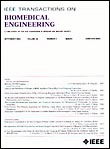 M. Mignotte, M. Meunier, J.-P. Soucy.
M. Mignotte, M. Meunier, J.-P. Soucy.
DCT-based complexity regularization for EM tomographic reconstruction.
IEEE Transactions on Biomedical Engineering,
55(2):801-805,February 2008.
Abstract:
This paper introduces a simple algorithm for tomographic reconstruction
based on the use of a complexity regularization term. The regularization
is formulated in the discrete cosine transform (DCT) domain by promoting
a low-noise reconstruction having a high sparsity in the frequency domain.
The resulting algorithm simply alternates between a maximum-likelihood (ML)
expectation-maximization (EM) update and a decreasing sparsity constraint
in the DCT domain. Applications to SPECT reconstruction and comparisons with
a classical estimator using the best available regularization terms are given
in order to illustrate the potential of our reconstruction technique.
Keywords:
Discrete cosine transform (DCT),
SPECT tomography, expectation-maximization (EM), reconstruction.
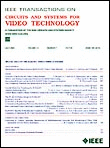 P.-M. Jodoin, M. Mignotte, J. Konrad.
P.-M. Jodoin, M. Mignotte, J. Konrad.
Statistical background subtraction methods using spatial cues.
IEEE Transactions on Circuits and Systems for Video Technology,
17(12):1758-1764, December 2007.
Abstract:
Most statistical background subtraction techniques are based on the analysis of
temporal color/intensity distribution. However, learning statistics on a series
of time frames can be problematic, especially when no frame absent of moving objects
is available or when the available memory is not sufficient to store the series
of frames needed for learning. In this letter, we propose a spatial variation to
the traditional temporal framework. The proposed framework allows statistical motion
detection with methods trained on one background frame instead of a series of frames
as is usually the case. Our framework includes two spatial background subtraction
approaches suitable for different applications. The first approach is meant for scenes
having a nonstatic background due to noise, camera jitter or animation in the scene
(e.g.,waving trees, fluttering leaves). This approach models each pixel with two PDFs:
one unimodal PDF and one multimodal PDF, both trained on one background frame. In this
way, the method can handle backgrounds with static and nonstatic areas. The second
spatial approach is designed to use as little processing time and memory as possible.
Based on the assumption that neighboring pixels often share similar temporal distribution,
this second approach models the background with one global mixture of Gaussians.
Keywords:
Background detection motion detection.
 P.-M. Jodoin, M. Mignotte, C. Rosenberger.
P.-M. Jodoin, M. Mignotte, C. Rosenberger.
Segmentation framework based on label field fusion.
IEEE Transactions on Image Processing,
16(10):2535-2550, October 2007.
Abstract:
In this paper, we put forward a novel fusion framework that mixes together
label fields instead of observation data as is usually the case. Our framework
takes as input two label fields: a quickly estimated and to-be-refined segmentation
map and a spatial region map that exhibits the shape of the main objects of the scene.
These two label fields are fused together with a global energy function that is
minimized with a deterministic iterative conditional mode algorithm. As explained
in the paper, the energy function may implement a pure fusion strategy or a fusion-reaction
function. In the latter case, a data-related term is used to make the optimization problem
well posed. We believe that the conceptual simplicity, the small number of parameters, the
use of a simple and fast deterministic optimizer that admits a natural implementation on a
parallel architecture are among the main advantages of our approach. Our fusion framework
is adapted to various computer vision applications among which are motion segmentation,
motion estimation and occlusion detection.
Keywords:
Color segmentation, label fusion, motion estimation,
motion segmentation, occlusion.
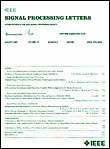 M. Mignotte.
M. Mignotte.
A post-processing deconvolution step for wavelet-based image denoising methods.
IEEE Signal Processing Letters,
4(9):621-624, September 2007.
Abstract:
In this letter, we show that the performance of image denoising algorithms
using wavelet transforms can be improved by a post-processing deconvolution
step that takes into account the inherent blur function created by the considered
wavelet based denoising system. The interest of the proposed deblurring procedure
is illustrated on denoised images reconstructed by shrinkage of curvelet and
undecimated wavelet coefficients. Experimental results reported here show that
the proposed post-processing technique yields improvements in term of image quality
and lower mean square error, especially when the image is corrupted by strong
additive white Gaussian noise.
Keywords:
Curvelet, deblurring, deconvolution, image denoising, nonnegative Garrote shrinkage,
undecimated wavelet transform.
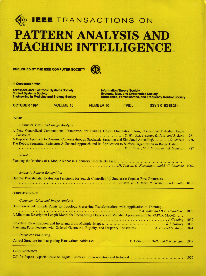 F. Destrempes, M. Mignotte, J.-F. Angers.
F. Destrempes, M. Mignotte, J.-F. Angers.
Localization of shapes using statistical models and stochastic optimization.
IEEE Transactions on Pattern Analysis and Machine Intelligence,
29(9):1603-1615, September 2007.
Abstract:
In this paper, we present a new model for deformations of shapes. A pseudolikelihood
is based on the statistical distribution of the gradient vector field of the gray level.
The prior distribution is based on the probabilistic principal component analysis (PPCA).
We also propose a new model based on mixtures of PPCA that is useful in the case of greater
variability in the shape. A criterion of global or local object specificity based on a preliminary
color segmentation of the image is included into the model. The localization of a shape in an image
is then viewed as minimizing the corresponding Gibbs field. We use the exploration/selection (E/S)
stochastic algorithm in order to find the optimal deformation. This yields a new unsupervised statistical
method for localization of shapes. In order to estimate the statistical parameters for the gradient
vector field of the gray level, we use an iterative conditional estimation (ICE) procedure.
The color segmentation of the image can be computed with an exploration/selection/estimation
(ESE) procedure.
Keywords:
Exploration/Selection (E/S) algorithm, Probabilistic Principal Component Analysis (PPCA),
Shape localization, statistical model, stochastic optimization.
 M. Mignotte.
M. Mignotte.
Image denoising by averaging of piecewise constant simulations of image partitions.
IEEE Transactions on Image Processing,
16(2):523-533, February 2007.
Abstract:
This paper investigates the problem of image denoising when
the image is corrupted by additive white Gaussian noise. We
herein propose a spatial adaptive denoising method which is
based on an averaging process performed on a set of Markov
Chain Monte-Carlo simulations of region partition maps constrained
to be spatially piecewise uniform (i.e., constant in the grey level
value sense) for each estimated constant-value regions. For the
estimation of these region partition maps, we have adopted the unsupervised
Markovian framework in which parameters are automatically estimated in
the least square sense. This sequential averaging allows to obtain, under
our image model, an approximation of the image to be recovered in the
minimal mean square sense error. The experiments reported in this paper
demonstrate that the discussed method performs competitively and sometimes
better than the best existing state-of-the-art wavelet-based denoising
methods in benchmark tests.
Keywords:
Image denoising, Markov chain Monte-Carlo (MCMC) simulations,
Markovian segmentation.
 F. Destrempes, J.-F. Angers, M. Mignotte.
F. Destrempes, J.-F. Angers, M. Mignotte.
Fusion of hidden Markov Random Field models and its Bayesian estimation.
IEEE Transactions on Image Processing,
15(10):2920-2935, October 2006.
Abstract:
In this paper, we present a Hidden Markov Random Field (HMRF) data-fusion model.
The proposed model is applied to the segmentation of natural images based on the
fusion of colors and textons into Julesz ensembles. The corresponding
Exploration/Selection/Estimation (ESE) procedure for the estimation of the parameters
is presented. This method achieves the estimation of the parameters of the Gaussian kernels,
the mixture proportions, the region labels, the number of regions, and the Markov
hyper-parameter. Meanwhile, we present a new proof of the asymptotic convergence of
the ESE procedure, based on original finite time bounds for the rate of convergence.
Keywords:
Bayesian estimation, Exploration/Selection algorithm, Exploration/Selection/Estimation procedure,
Julesz ensembles, Markov Chain Monte Carlo (MCMC) algorithm, color and texture segmentation,
fusion of hidden Markov random field models.
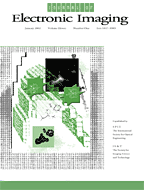 P.-M. Jodoin, M. Mignotte.
P.-M. Jodoin, M. Mignotte.
Markovian segmentation and parameter estimation on graphics hardware.
Journal of Electronic Imaging, 15(3):033005-1-15, 2006.
Abstract:
In this paper, we show how Markovian strategies used to solve
well-known segmentation problems such as motion estimation,
motion detection, motion segmentation, stereovision, and color
segmentation can be significantly accelerated when implemented
on programmable graphics hardware. More precisely, we expose how
the parallel abilities of a standard graphics processing unit
usually devoted to image synthesis can be used to infer the labels
of a segmentation map. The problems we address are stated in the
sense of the maximum a posteriori with an energy-based or probabilistic
formulation, depending on the application. In every case, the label field
is inferred with an optimization algorithm such as iterated conditional
mode (ICM) or simulated annealing. In the case of probabilistic segmentation,
mixture parameters are estimated with the K-means and the iterative conditional
estimation (ICE) procedure. For both the optimization and the parameter estimation
algorithms, the graphics processor unit's (GPU's) fragment processor is used to
update in parallel every labels of the segmentation map, while rendering passes
and graphics textures are used to simulate optimization iterations. The hardware
results obtained with a mid-end graphics card, show that these Markovian
applications can be accelerated by a factor of 4 to 200 without requiring
any advanced skills in hardware programming.
Keywords:
 M. Mignotte.
M. Mignotte.
Segmentation-based regularization term for image deconvolution.
IEEE Transactions on Image Processing,
15(7):1973-1984, July 2006.
Abstract:
This paper proposes a new and original inhomogeneous restoration
(deconvolution) model under the Bayesian framework for observed
images degraded by space-invariant blur and additive Gaussian noise.
In this model, regularization is achieved during the iterative restoration
process with a segmentation-based a priori term. This adaptive edge-preserving
regularization term applies a local smoothness constraint to pre-estimated
constant-valued regions of the target image. These constant-valued regions
(the segmentation map) of the target image are obtained from a preliminary
Wiener deconvolution estimate. In order to estimate reliable segmentation
maps, we have also adopted a Bayesian Markovian framework in which the
regularized segmentations are estimated in the maximum a posteriori (MAP)
sense with the joint use of local Potts prior and appropriate Gaussian
conditional luminance distributions. In order to make these segmentations
unsupervised, these likelihood distributions are estimated in the maximum
likelihood sense. To compute the MAP estimate associated to the restoration,
we use a simple steepest descent procedure resulting in an efficient iterative
process converging to a globally optimal restoration. The experiments reported
in this paper demonstrate that the discussed method performs competitively and
sometimes better than the best existing state-of-the-art methods in benchmark tests.
Keywords:
Adaptive prior model, Bayesian estimation, Markovian model,
Tikhonov regularization,image deconvolution or restoration,
image segmentation.
 S. Benameur, M. Mignotte, H. Labelle, J.A. De Guise.
S. Benameur, M. Mignotte, H. Labelle, J.A. De Guise.
A hierarchical statistical modeling approach for the unsupervised
3D biplanar reconstruction of the scoliotic spine.
IEEE Transactions on Biomedical Engineering,
52(12), pp.2041- 2057, December 2005.
Abstract: This paper presents a new and accurate 3D
reconstruction technique for the scoliotic spine from a pair of planar
and conventional (postero-anterior with normal incidence and lateral)
calibrated radiographic images. The proposed model uses a priori
hierarchical global knowledge, both on the geometric structure of the
whole spine and of each vertebra. More precisely, it relies on the
specification of two 3D statistical templates. The first, a rough
geometric template on which rigid admissible deformations are defined,
is used to ensure a crude registration of the whole spine. An accurate
3D reconstruction is then performed for each vertebra by a second
template on which non-linear admissible global, as well as local
deformations, are defined. Global deformations are modeled using a
statistical modal analysis of the pathological deformations observed
on a representative scoliotic vertebra population. Local deformations
are represented by a first order Markov process. This unsupervised
coarse-to-fine 3D reconstruction procedure leads to two separate
minimization procedures efficiently solved in our application with
evolutionary stochastic optimization algorithms. In this context, we
compare the results obtained with a classical Genetic Algorithm (GA)
and a recent Exploration Selection (ES) technique. This latter
optimization method with the proposed 3D reconstruction model, is
tested on several pairs of biplanar radiographic images with scoliotic
deformities. The experiments reported in this paper demonstrate that
the discussed method is comparable in terms of accuracy with the
classical CT-scan technique while being unsupervised and while
requiring only two radiographic images and a lower amount of radiation
for the patient.
Keywords:
3D reconstruction model, 3D/2D registration,
hierarchical statistical modeling, shape model, biplanar
radiographies, scoliosis, medical imaging, energy function
minimization, stochastic optimization.
 S. Benameur, M. Mignotte, F. Destrempes, J.A. De Guise.
S. Benameur, M. Mignotte, F. Destrempes, J.A. De Guise.
3D biplanar reconstruction of scoliotic rib cage using the estimation of
a mixture of probabilistic prior models.
IEEE Transactions on Biomedical Engineering,
52(10):1713-1728, October 2005.
Abstract: In this paper, we present an original method for the
3D reconstruction of the scoliotic rib cage from a planar
and a conventional pair of calibrated radiographic images
(postero-anterior with normal incidence and lateral). To this end, we
first present a robust method for estimating the model parameters in a
mixture of Probabilistic Principal Component Analysers (PPCA). This
method is based on the Stochastic Expectation Maximization (SEM)
algorithm. Parameters of this mixture model are used to constrain the
3D biplanar reconstruction problem of scoliotic rib cage. More
precisely, the proposed PPCA mixture model is exploited for
dimensionality reduction and to obtain a set of probabilistic prior
models associated with each detected class of pathological
deformations observed on a representative training scoliotic rib cage
population. By using an appropriate likelihood, for each considered
class-conditional prior model, the proposed 3D reconstruction is
stated as an energy function minimization problem, which is solved
with an exploration/selection algorithm. The optimal 3D reconstruction
then corresponds to the class of deformation and parameters leading to
the minimal energy. This 3D method of reconstruction has been
successfully tested and validated on a database of 20 pairs of
biplanar radiographic images of scoliotic patients, yielding very
promising results. As an alternative to CT-scan 3D reconstruction this
scheme has the advantage of low radiation for the patient, and may
also be used for diagnosis and evaluation of deformity of a scoliotic
rib cage. The proposed method remains sufficiently general to be
applied to other reconstruction problems for which a database of
objects to be reconstructed is available (with two or more
radiographic views).
Keywords:
3D reconstruction model, 3D/2D registration, shape model, reduction of dimensionality,
mixtures of probabilistic principal component analysers, biplanar
radiographies, scoliosis, medical imaging, stochastic optimization.
 F. Destrempes, M. Mignotte, J.-F. Angers.
F. Destrempes, M. Mignotte, J.-F. Angers.
A stochastic method for Bayesian estimation of Hidden Markov Random Field
models with application to a color model.
IEEE Transactions on Image Processing,
14(8):1096-1124, August 2005.
Abstract:
We propose a new stochastic algorithm for computing
useful Bayesian estimators of hidden Markov random field (HMRF) models
that we call exploration/selection/estimation (ESE) procedure. The
algorithm is based on an optimization algorithm of O. Francois, called
the exploration/selection (E/S) algorithm. The novelty consists of
using the a posteriori distribution of the HMRF, as exploration
distribution in the E/S algorithm. The ESE procedure computes the
estimation of the likelihood parameters and the optimal number of
region classes, according to global constraints, as well as the
segmentation of the image. In our formulation, the total number of
region classes is fixed, but classes are allowed or disallowed
dynamically. This framework replaces the mechanism of the
split-and-merge of regions that can be used in the context of image
segmentation. The procedure is applied to the estimation of a HMRF
color model for images, whose likelihood is based on multivariate
distributions, with each component following a Beta
distribution. Meanwhile, a method for computing the maximum likelihood
estimators of Beta distributions is presented. Experimental results
performed on 100 natural images are reported. We also include a proof
of convergence of the E/S algorithm in the case of nonsymmetric
exploration graphs.
Keywords:
Bayesian estimation of hidden Markov random field (HMRF) models
color model exploration/selection (E/S) algorithm
image segmentation maximum likelihood (ML) estimation
of Beta distributions.
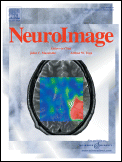 J.-F. Laliberté, J. Meunier, M. Mignotte, J.P. Soucy.
J.-F. Laliberté, J. Meunier, M. Mignotte, J.P. Soucy.
Detection of diffuse abnormal perfusion in SPECT using a normal brain atlas.
NeuroImage,
23(2):561-8, October 2004.
Abstract: Visual assessment, with significant inter- or
intraobserver variability, is still the norm for the evaluation of
Single Photon Emission Computerized Tomography (SPECT) cerebral
perfusion studies. We present in this paper an automated method for
screening SPECT studies to detect diffuse disseminated abnormalities
based on a computerized atlas of normal regional cerebral blood flow
(rCBF). To generate the atlas, a set of normal brain SPECT studies are
registered together. The atlas contains the intensity mean, the
nonlinear displacement mean, and the variance of the activity
pattern. A patient is then evaluated by registering his or her SPECT
volume to the atlas and computing the nonlinear 3-D displacement of
each voxel needed for the best shape fit to it. A voxel is counted as
"abnormal" if the intensity difference between the atlas and the
registered patient (or if the 3-D motion necessary to move the voxel
to its registered position) is superior to 3 SD of normal mean. The
number of abnormal voxels is used to classify studies. We validated
this approach on 24 SPECT perfusion studies selected visually for
having clear diffuse anomalies and 21 normal studies. A Markovian
segmentation algorithm is also used to identify the white and gray
matters for regional analysis. Based on the number of abnormal voxels,
two supervised classifiers were tested: (1) minimum distance-to-mean
and (2) Bayesian. The analysis of the intensity and displacement
"abnormal" voxels allow one to achieve an 80% correct classification
rate for the whole brain and a 93% rate if we consider only voxels in
the segmented gray matter region.
Keywords:
SPECT images, brain atlas, diffuse abnormal perfusion.
 F. Destrempes, M. Mignotte.
F. Destrempes, M. Mignotte.
A statistical model for contours in images.
IEEE Transactions on Pattern Analysis and Machine Intelligence,
26(2):184-197, May 2004.
Abstract:
In this paper, we describe a statistical model for
the gradient vector field of the gray level in images validated by
different experiments. Moreover, we present a global constrained
Markov model for contours in images that uses this statistical model
for the likelihood. Our model is amenable to an Iterative Conditional
Estimation (ICE) procedure for the estimation of the parameters; our
model also allows segmentation by means of the Simulated Annealing
(SA) algorithm, the Iterated Conditional Modes (ICM) algorithm, or the
Modes of Posterior Marginals (MPM) Monte Carlo (MC) algorithm. This
yields an original unsupervised statistical method for edge-detection,
with three variants. The estimation and the segmentation procedures
have been tested on a total of 160 images. Those tests indicate that
the model and its estimation are valid for applications that require
an energy term based on the log-likelihood ratio. Besides
edge-detection, our model can be used for semiautomatic extraction of
contours, localization of shapes, non-photo-realistic rendering; more
generally, it might be useful in various problems that require a
statistical likelihood for contours.
Keywords:
Contours in images, edge-detection, parameter estimation, unsupervised
statistical segmentation, Markov Random Field model.
 M. Mignotte.
M. Mignotte.
Nonparametric multiscale energy-based model and its application in some imagery problems.
IEEE Transactions on Pattern Analysis and Machine Intelligence,
26(2):184-197, February 2004.
Abstract:
This paper investigates the use of a nonparametric
regularization energy term for devising a example-based rendering and
segmentation technique. We have stated this problem in the
multiresolution energy minimization framework and exploited the
multiscale structure proposed by Wei and Levoy for the texture
synthesis problem. In this nonparametric energy minimization
framework, we also propose a computationally efficient coarse-to-fine
recursive optimization method to minimize the cost function related to
this hierarchical model. In this context, the formulation of our
example-based regularization term also allows to directly infer an
intuitive dissimilarity measure between two contour shapes. This
measure is herein exploited to define an efficient shape descriptor
for the contour-based shape recognition and indexing problem.
Keywords: Nonparametric multiscale energy-based
(or multiresolution example-based) model, inpainting,
Non-Photorealistic Rendering (NPR), segmentation,
contour-based shape recognition, shape indexing.
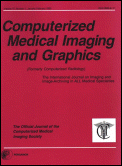
S. Benameur, M. Mignotte, S. Parent, H. Labelle, W. Skalli, J. De Guise.
3D/2D registration and segmentation of
scoliotic vertebrae using statistical models.
Computerized Medical Imaging and Graphics, July 2003.
Abstract:
We propose a new 3D/2D registration method for vertebrae of the
scoliotic spine, using two conventional radiographic views
(postero-anterior and lateral), and a priori global knowledge of the
geometric structure of each vertebra. This geometric knowledge is
efficiently captured by a statistical deformable template integrating a
set of admissible deformations, expressed by the first modes of
variation in Karhunen-Loeve expansion, of the pathological deformations
observed on a representative scoliotic vertebra population. The proposed
registration method consists of fitting the projections of this
deformable template with the preliminary segmented contours of the
corresponding vertebra on the two radiographic views. The 3D/2D
registration problem is stated as the minimization of a cost function
for each vertebra and solved with a gradient descent technique.
Registration of the spine is then done vertebra by vertebra. The
proposed method efficiently provides accurate 3D reconstruction of each
scoliotic vertebra and, consequently, it also provides accurate
knowledge of the 3D structure of the whole scoliotic spine. This
registration method has been successfully tested on several biplanar
radiographic images and validated on 57 scoliotic vertebrae. The
validation results reported in this paper demonstrate that the proposed
statistical scheme performs better than other conventional 3D
reconstruction methods.
Keywords:
3D/2D Registration, 3D reconstruction model, statistical deformable model,
shape model, biplanar radiographies, scoliosis, medical imaging, energy function
optimization.
 M. Mignotte, J. Meunier, J.-P. Soucy, C. Janicki.
M. Mignotte, J. Meunier, J.-P. Soucy, C. Janicki.
Comparison of deconvolution techniques using a distribution
mixture parameter estimation: application in spect imagery.
Journal of Electronic Imaging, 11(1), 2002.
Abstract:
Thanks to its ability to yield functionally rather than
anatomically-based information, the SPECT imagery technique has
become a great help in the diagnostic of cerebrovascular diseases
which are the third most common cause of death in the USA and
Europe. Nevertheless, SPECT images are very blurred and consequently
their interpretation is difficult. In order to improve the spatial
resolution of these images and then to facilitate their interpretation
by the clinician, we propose to implement and to compare the
effectiveness of different existing ``blind'' or ``supervised''
deconvolution methods. To this end, we present an accurate
distribution mixture parameter estimation procedure which takes into
account the diversity of the laws in the distribution mixture of a
SPECT image. In our application, parameters of this distribution
mixture are efficiently exploited in order to prevent overfitting of
the noisy data for the iterative deconvolution techniques without
regularization term, or to determine the exact support of the object
to be restored when this one is needed. Recent blind deconvolution
techniques such as the NAS-RIF algorithm, combined
with this estimation procedure, can be efficiently applied in SPECT
imagery and yield promising results.
Keywords:
SPECT imagery, blind deconvolution, distribution mixture estimation,
Markov Random Field model, image restoration
 M. Mignotte, J. Meunier, J.-C. Tardif.
M. Mignotte, J. Meunier, J.-C. Tardif.
Endocardial boundary estimation and tracking in echocardiographic images
using deformable templates and Markov Random Fields.
Pattern Analysis and Applications, 4(4):256-271, November 2001.
Abstract:
We present a new approach to shape-based segmentation and tracking of
deformable anatomical structures in medical images and validate this
approach by detecting and tracking the endocardial contour in an
echocardiographic image sequence. To this end, some global prior
shape knowledges of the endocardial boundary is captured by a
prototype template with a set of predefined global and local
deformations to take into account its inherent natural variability
over time. In this deformable model-based Bayesian segmentation, the
data likelihood model relies on an accurate statistical modeling of
the grey level distribution of each class present in the ultrasound
image. The parameters of this distribution mixture are given by a
preliminary iterative estimation step. This estimation scheme relies
on a Markov Random Field prior model and takes into account the
imaging process as well as the distribution shape of each class
present in the image. Then the detection and the tracking problem is
stated in a Bayesian framework where it ends up as a cost function
minimization problem for each image of the sequence. In our
application, this energy optimization problem is efficiently solved by
a genetic algorithm combined with a steepest ascent procedure. This
technique has been successfully applied on synthetic images and on a
real echocardiographic image sequence.
Keywords:
Deformable templates, Markov Random Fields,
Tracking, Echocardiography, Boundary estimation.
 M. Mignotte, J. Meunier.
M. Mignotte, J. Meunier.
A multiscale optimization approach for the dynamic
contour-based boundary detection issue.
Computerized Medical Imaging and Graphics,
25(3):265-275, May 2001.
Abstract:
We present a new multiscale approach for deformable contour
optimization. The method relies on a multigrid minimization method and
a coarse-to-fine relaxation algorithm. This approach consists in
minimizing a cascade of optimization problems of reduced and
increasing complexity instead of considering the minimization problem
on the full and original configuration space. Contrary to classical
multiresolution algorithms, no reduction of image is applied. The
family of defined energy functions are derived from the original (full
resolution) objective function, ensuring that the same function is
handled at each scale and that the energy decreases at each step of
the deformable contour minimization process. The efficiency and the
speed of this multiscale optimization strategy is demonstrated in the
difficult context of the minimization of a region-based contour energy
function ensuring the boundary detection of anatomical structures in
ultrasound medical imagery. In this context, the proposed multiscale
segmentation method is compared to other classical region-based
segmentation approaches such as Maximum Likelihood or Markov Random
Field-based segmentation techniques. We also extend this multiscale
segmentation strategy to active contour models using a classical
edge-based likelihood approach. Finally, time and performance
analysis of this approach, compared to the (commonly used) dynamic
programming-based optimization procedure, is given and allows to
attest the accuracy and the speed of the proposed method.
Keywords:
active contour model, snake, multiscale optimization,
boundary-based segmentation, ultrasound medical images.
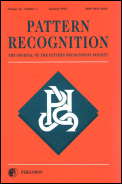 K.C. Yao, M. Mignotte, C. Collet, P. Galerne, G. Burel.
K.C. Yao, M. Mignotte, C. Collet, P. Galerne, G. Burel.
Unsupervised segmentation using a SOM and a
noise model estimation in sonar imagery.
Pattern Recognition,
33(9):1575-1584, September 2000.
Abstract:
This work deals with unsupervised sonar image segmentation. We present a new
estimation and segmentation procedure on images provided by a high-resolution
sonar. The sonar image is segmented into two kinds of regions: shadow
(corresponding to a lack of acoustic reverberation behind each object lying on the
seabed) and reverberation (due to the reflection of acoustic wave on the seabed and
on the objects). The unsupervised contextual method we propose is defined as a
two-step process. Firstly, the iterative conditional estimation is used for the
estimation step in order to estimate the noise model parameters and to accurately
obtain the proportion of each class in the maximum likelihood sense. Then, the
learning of a Kohonen self-organizing map (SOM) is performed directly on the input
image to approximate the discriminating functions, i.e. the contextual distribution
function of the grey levels. Secondly, the previously estimated proportion, the
contextual information and the Kohonen SOM, after learning, are then used in the
segmentation step in order to classify each pixel on the input image. This technique
has been successfully applied to real sonar images, and is compatible with an
automatic processing of massive amounts of data.
Keywords:
Kohonen self-organizing map, segmentation, parameter estimation, sonar imagery,
Markov random field.
 M. Mignotte, C. Collet, P. Pérez, P. Bouthemy.
M. Mignotte, C. Collet, P. Pérez, P. Bouthemy.
Markov Random Field and Fuzzy logic modeling in sonar imagery: application
to the classification of underwater floor.
Computer Vision and Image Understanding,
79(1):4-24, July 2000.
Abstract:
This paper proposes an original method for the classification of
seafloors from high resolution sidescan sonar images. We aim at
classifying the sonar images into five kinds of regions: sand,
pebbles, rocks, ripples, and dunes. The proposed method adopts a
pattern recognition approach based on the extraction and the analysis
of the cast shadows exhibited by each seabottom type. This method
consists of three stages of processing. First, the original image is
segmented into two kinds of regions: shadow (corresponding to a lack
of acoustic reverberation behind each "object" lying on the seabed)
and seabottom reverberation. Second, based on the extracted shadows,
shape parameter vectors are computed on subimages and classified with
a fuzzy classifier. This preliminary classification is finally refined
thanks to a Markov random field model which allows to incorporate
spatial homogeneity properties one would expect for the final
classification map. Experiments on a variety of real high-resolution
sonar images are reported.
Keywords:
Sonar imagery, sea-bed classification, shape
recognition, Markov Random Field (MRF), fuzzy logic.
 M. Mignotte, C. Collet, P. Pérez, P. Bouthemy.
M. Mignotte, C. Collet, P. Pérez, P. Bouthemy.
Sonar image segmentation using a hierarchical MRF model.
IEEE Transactions on Image Processing,
9(7):1216-1231, July 2000.
Abstract:
This paper is concerned with hierarchical Markov Random Field (MRF)
models and their application to sonar image segmentation. We present
an original hierarchical segmentation procedure devoted to images
given by a high resolution sonar. The sonar image is segmented into
two kinds of regions: shadow (corresponding to a lack of acoustic
reverberation behind each object lying on the sea-bed) and sea-bottom
reverberation. The proposed unsupervised scheme takes into account
the variety of the laws in the distribution mixture of a sonar image,
and it estimates both the parameters of noise distributions and the
parameters of the Markovian prior. For the estimation step, we use an
iterative technique which combines a maximum likelihood approach (for
noise model parameters) with a least-squares method (for MRF-based
prior). In order to model more precisely the local and global
characteristics of image content at different scales, we introduce a
hierarchical model involving a pyramidal label field. It combines
coarse-to-fine causal interactions with a spatial neighborhood
structure. This new method of segmentation, called Scale Causal
Multigrid (SCM) algorithm, has been successfully applied to real sonar
images and seems to be well suited to the segmentation of very noisy
images. The experiments reported in this paper demonstrate that the
discussed method performs better than other hierarchical schemes for
sonar image segmentation.
Keywords: Hierarchical MRF, parameter estimation, sonar imagery,
unsupervised segmentation.
 M. Mignotte, J. Meunier.
M. Mignotte, J. Meunier.
Three-dimensional blind deconvolution of SPECT images.
IEEE Transactions on Biomedical Engineering,
47(2):274-281, February 2000.
Abstract:
Thanks to its ability to yield functionally rather than
anatomically-based information, the three-dimensional (3D) {SPECT}
imagery technique has become a great help in the diagnostic of
cerebrovascular diseases. Nevertheless, due to the imaging process,
the 3D SPECT images are very blurred and consequently their
interpretation by the clinician is often difficult and subjective. In
order to improve the resolution of these 3D images and then to
facilitate their interpretation, we propose herein, to extend a recent
image blind deconvolution technique (called the NAS-RIF deconvolution
method) in order to improve both the spatial and the inter-slice
resolution of SPECT volumes. This technique requires a preliminary
step in order to find the support of the object to be restored. In
this paper, we propose to solve this problem with an unsupervised 3D
Markovian segmentation technique. This method has been successfully
tested on numerous real and simulated brain SPECT volumes, yielding
very promising restoration results.
Keywords:
SPECT imagery, 3D blind deconvolution, unsupervised segmentation,
Markov Random Field model, image restoration.
 M. Mignotte, C. Collet, P. Pérez, P. Bouthemy.
M. Mignotte, C. Collet, P. Pérez, P. Bouthemy.
Hybrid genetic optimization and statistical model-based
approach for the classification of shadow shapes in sonar imagery.
IEEE Transactions on Pattern Analysis and Machine Intelligence,
22(2):129-141, February 2000.
Abstract:
We present an original statistical classification method using a
deformable template model to separate natural objects from man-made
objects in an image provided by a high resolution sonar. A prior
knowledge of the manufactured object shadow shape is captured by a
prototype template, along with a set of admissible linear
transformations, to take into account the shape variability. Then, the
classification problem is defined as a two-step process. First, the
detection problem of a region of interest in the input image is stated
as the minimization of a cost function. Second, the value of this
function at convergence allows one to determine whether the desired
object is present or not in the sonar image. The energy minimization
problem is tackled using relaxation techniques. In this context, we
compare the results obtained with a deterministic relaxation technique
(a gradient-based algorithm) and two stochastic relaxation methods:
Simulated Annealing (SA) and a hybrid Genetic Algorithm (GA). This
latter method has been successfully tested on real and synthetic sonar
images, yielding very promising results.
Keywords:
Deformable template, objective function, simulated annealing,
gradient-based algorithm, genetic optimization, shape recognition,
sonar imagery.
 M. Mignotte, C. Collet, P. Pérez, P. Bouthemy.
M. Mignotte, C. Collet, P. Pérez, P. Bouthemy.
Three-class Markovian segmentation of high resolution sonar images.
Computer Vision and Image Understanding,
76(3):191-204, December 1999.
Abstract:
This paper presents an original method for analyzing, in an
unsupervised way, images supplied by high resolution sonar. We aim at
segmenting the sonar image into three kinds of regions: echo areas
(due to the reflection of the acoustic wave on the object), shadow
areas (corresponding to a lack of acoustic reverberation behind an
object lying on the sea-bed), and sea-bottom reverberation areas. This
unsupervised method estimates the parameters of noise distributions,
modeled by a Weibull probability density function (PDF), and the label
field parameters, modeled by a Markov random field (MRF). For the
estimation step, we adopt a maximum likelihood technique for the noise
model parameters and a least-squares method to estimate the MRF prior
model. Then, in order to obtain an accurate segmentation map, we have
designed a two-step process that finds the shadow and the echo regions
separately, using the previously estimated parameters. First, we
introduce a scale-causal and spatial model called SCM (scale causal
multigrid), based on a multigrid energy minimization strategy, to find
the shadow class. Second, we propose a MRF monoscale model using a
priori information (at different level of knowledge) based on physical
properties of each region, which allows us to distinguish echo areas
from sea-bottom reverberation. This technique has been successfully
applied to real sonar images and is compatible with automatic
processing of massive amounts of data.
Keywords:
sonar imagery, unsupervised segmentation, MRF hierarchical model,
Weibull law, noise model estimation.
 P.-M. Jodoin, M. Mignotte.
P.-M. Jodoin, M. Mignotte. M. Mignotte.
M. Mignotte. M. Mignotte.
M. Mignotte. M. Mignotte, M. Meunier, J.-P. Soucy.
M. Mignotte, M. Meunier, J.-P. Soucy.
 P.-M. Jodoin, M. Mignotte, J. Konrad.
P.-M. Jodoin, M. Mignotte, J. Konrad. P.-M. Jodoin, M. Mignotte, C. Rosenberger.
P.-M. Jodoin, M. Mignotte, C. Rosenberger. M. Mignotte.
M. Mignotte.  F. Destrempes, M. Mignotte, J.-F. Angers.
F. Destrempes, M. Mignotte, J.-F. Angers.  M. Mignotte.
M. Mignotte. F. Destrempes, J.-F. Angers, M. Mignotte.
F. Destrempes, J.-F. Angers, M. Mignotte. P.-M. Jodoin, M. Mignotte.
P.-M. Jodoin, M. Mignotte.
 M. Mignotte.
M. Mignotte. S. Benameur, M. Mignotte, H. Labelle, J.A. De Guise.
S. Benameur, M. Mignotte, H. Labelle, J.A. De Guise.
 S. Benameur, M. Mignotte, F. Destrempes, J.A. De Guise.
S. Benameur, M. Mignotte, F. Destrempes, J.A. De Guise.
 F. Destrempes, M. Mignotte, J.-F. Angers.
F. Destrempes, M. Mignotte, J.-F. Angers. J.-F. Laliberté, J. Meunier, M. Mignotte, J.P. Soucy.
J.-F. Laliberté, J. Meunier, M. Mignotte, J.P. Soucy. F. Destrempes, M. Mignotte.
F. Destrempes, M. Mignotte.  M. Mignotte.
M. Mignotte. 
 M. Mignotte, J. Meunier, J.-P. Soucy, C. Janicki.
M. Mignotte, J. Meunier, J.-P. Soucy, C. Janicki.
 M. Mignotte, J. Meunier, J.-C. Tardif.
M. Mignotte, J. Meunier, J.-C. Tardif.
 M. Mignotte, J. Meunier.
M. Mignotte, J. Meunier.
 K.C. Yao, M. Mignotte, C. Collet, P. Galerne, G. Burel.
K.C. Yao, M. Mignotte, C. Collet, P. Galerne, G. Burel.
 M. Mignotte, C. Collet, P. Pérez, P. Bouthemy.
M. Mignotte, C. Collet, P. Pérez, P. Bouthemy. M. Mignotte, C. Collet, P. Pérez, P. Bouthemy.
M. Mignotte, C. Collet, P. Pérez, P. Bouthemy.  M. Mignotte, J. Meunier.
M. Mignotte, J. Meunier. M. Mignotte, C. Collet, P. Pérez, P. Bouthemy.
M. Mignotte, C. Collet, P. Pérez, P. Bouthemy.  M. Mignotte, C. Collet, P. Pérez, P. Bouthemy.
M. Mignotte, C. Collet, P. Pérez, P. Bouthemy.